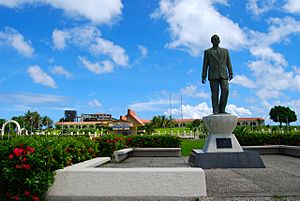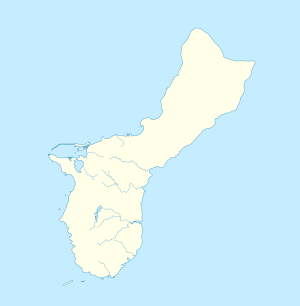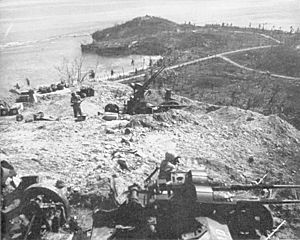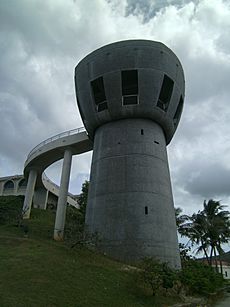Adelup Point facts for kids
Quick facts for kids Adelup Point |
|
|---|---|
| Ricardo J. Bordallo Governor's Complex | |

The Ricardo J. Bordallo Governor's Complex on Adelup Point
|
|
| Coordinates | 13°28′47″N 144°43′47″E / 13.4797°N 144.7296°E |
Adelup Point is a piece of land that sticks out into the Philippine Sea in Hagåtña, Guam. It is made of limestone. This point separates two bays: Asan Bay and Hagåtña Bay. Since 1990, it has been home to the Ricardo J. Bordallo Governor's Complex. Because of this, when people say "Adelup," they often mean the Office of the Governor of Guam.
What is Adelup Point Made Of?
Adelup Point is mostly made of a type of rock called limestone. This specific limestone is known as "Mariana limestone." It formed from ancient coral reefs. This means it's a very strong, porous, and often cavernous white rock. It was created from corals and tiny plants called Coralline algae growing together. The areas next to Adelup Point, along the coast, have deposits of beach sand and gravel.
A Look Back at Adelup Point's History
Before 1941, there was a large house called the "Atkins-Kroll house" on the highest part of Adelup Point. Atkins, Kroll, and Co. was a trading company that exported a product called copra from Guam. When Japan invaded Guam in 1941, the Japanese military used this house for their commander.
During the time Japan occupied Guam (1941-1944), Adelup Point was heavily fortified. The Imperial Japanese Navy built many defenses, including large coastal guns. On July 21, 1944, U.S. forces landed on the nearby Asan Invasion Beach. This marked the start of the Liberation of Guam. Adelup Point was the eastern edge of this invasion beach. There was fierce fighting, but U.S. forces captured the point by the end of that day. Today, you can still find seven pillboxes, caves, and other Japanese defenses on Adelup. One of these was dug under the old Atkins-Kroll House foundation. During the battle, this spot became an American command post.
After the war, in 1945, a naval construction headquarters was set up at Adelup. Later, a club for military officers was built there. In 1978, the War in the Pacific National Historical Park was created. Part of Adelup Point, including its western shore, is now inside this park. Adelup used to be part of the village of Asan-Maina. However, it was later added to Hagåtña. This made sure Hagåtña remained the main seat of the Government of Guam. In 1994, the Guam Museum opened an exhibition hall at Adelup. It had not had a permanent home since its old building was destroyed during the American invasion. The museum stayed there until 2002, when it was damaged by strong storms called Typhoon Chataan and Typhoon Pongsona. This forced it to close.
In March 2010, the 80 feet (24 m)-tall Latte of Freedom opened at Adelup. This structure serves as a viewing platform over the ocean. It is shaped like a latte stone, which is a symbol of the strong CHamoru culture. The Latte of Freedom is next to where the old Guam Museum used to be. That building was turned into a Hall of Governors. This hall honors all the governors since the Guam Organic Act of 1950 was signed.
What Can You See at Adelup Point Today?
Adelup Point is home to the Governor's offices and other government agencies. It also has many historical and cultural sites:
- A Japanese anti-aircraft gun from World War II. It was used for coastal defense. Nearby, there is a small Shinto shrine and a torii gate that promote peace.
- Bronze statues from 1994. These show two Chamorro scouts guiding U.S. Marines after they landed on Guam.
- A large grassy field. This field is used for sports and sometimes for military helicopter training by the Guam Army National Guard.
- A memorial monument. This monument remembers the crew who were lost in the 2008 B-52 crash off the coast of Guam.
- A replica of The Lone Sailor statue, put up in 2018. This statue honors the U.S. Navy, Marine Corps, and Coast Guard. They helped about 110,000 South Vietnamese refugees after the Fall of Saigon in 1975. The statue faces north towards Ritidian Point. It is next to a large replica of the Seal of Guam. Around it are 19 benches, each representing one of the Villages of Guam.
- Adelup Point is also the starting point for the yearly Liberation Day Parade.




